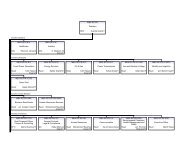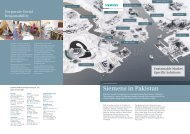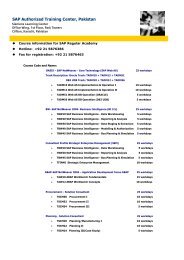Create successful ePaper yourself
Turn your PDF publications into a flip-book with our unique Google optimized e-Paper software.
Ten Effective ways to avoid Stress<br />
By: Dr. Kamran Farooqui<br />
CMO<br />
In our April 2007<br />
issue we had<br />
discussed about<br />
Stress: what is it,<br />
how it manifests<br />
and affects our<br />
body and why does<br />
it arise? We had also disclosed our<br />
intention to follow it up with tips to tackle<br />
it successfully in our subsequent issue.<br />
Well! We now present some useful and<br />
effective instructions for combating this<br />
niggling condition.<br />
1. Decrease or Discontinue<br />
Caffeine<br />
Many of us do not realize that caffeine<br />
(coffee, tea, chocolate and cola) is a drug,<br />
a strong stimulant that actually generates<br />
a stress reaction in the body. 75% to 80%<br />
of those who stop caffeine notice a<br />
benefit. They feel more relaxed, less jittery<br />
or nervous, sleep better, have more<br />
energy (a paradox, since you are removing<br />
a stimulant), less heartburn and fewer<br />
muscle aches. Many feel dramatically<br />
better and notice a remarkable difference.<br />
One warning, however. Heavy caffeine<br />
users must wean themselves gradually or<br />
they might get migraine-type withdrawal<br />
headaches. Try to decrease by one drink<br />
per day until you have freed yourself<br />
completely.<br />
2. Exercise<br />
Regular exercise can drain off ongoing<br />
stress and keep things under control. At<br />
the very least, it is important to exercise<br />
three times per week for a minimum of<br />
30 minutes each time. Aerobic activities<br />
like walking, jogging, swimming and<br />
bicycling are suitable. Choose things you<br />
like and those that you can maintain for a<br />
longer period. It is also beneficial to have<br />
a variety of exercise outlets. For chronic<br />
or acute stress, exercise is an essential<br />
ingredient in any stress reduction program.<br />
3. Relaxation / Meditation<br />
Just as we are all capable of mounting and<br />
sustaining a stress reaction, we have also<br />
inherited the ability to put our bodies into<br />
a state of deep relaxation which Dr. Herbert<br />
Benson of Harvard University has named<br />
"the relaxation response." In this state, all<br />
the physiologic events in the stress reaction<br />
are reversed: pulse slows, blood pressure<br />
falls, breathing slows and muscles relax.<br />
Where the stress reaction is automatic,<br />
however, the relaxation response needs to<br />
be brought forth by intention. Relaxation<br />
is more than simply having peace of mind,<br />
resting or enjoying a hobby. Deep relaxation<br />
can help you manage stress, and stay alert,<br />
energetic and productive. Fortunately, there<br />
are many ways of doing this.<br />
Relaxation techniques<br />
So how do you truly relax? These<br />
techniques can help you get started. Don't<br />
be discouraged if you don't feel the benefits<br />
right away. Be patient, take your time and<br />
practice and stay motivated.<br />
Relaxed breathing<br />
Have you ever noticed how you breathe<br />
when you're stressed? Stress typically<br />
causes rapid, shallow breathing. This kind<br />
of breathing sustains other aspects of the<br />
stress response, such as rapid heart rate<br />
and perspiration. If you could get control<br />
your breathing, you could avoid cascading<br />
events of acute stress.<br />
Practice this basic technique twice a day,<br />
every day, and whenever you feel tense.<br />
Follow these steps:<br />
l Inhale. With your mouth closed and<br />
your shoulders relaxed, inhale as slowly<br />
and deeply as you can to the count of<br />
six. As you do that, push your stomach<br />
out. Allow the air to fill your diaphragm.<br />
l Hold. Keep the air in your lungs as you<br />
slowly count to four.<br />
l Exhale. Release the air through your<br />
mouth as you slowly count to six.<br />
l Repeat. Complete the inhale-holdexhale<br />
cycle three to five times.<br />
Progressive muscle relaxation<br />
The goal of progressive muscle relaxation<br />
is to reduce the tension in your muscles.<br />
First, find a quiet place where you'll be free<br />
from interruption. Loosen tight clothing<br />
and remove your glasses or contacts if<br />
you'd like.<br />
Tense each muscle group for at least five<br />
seconds and then relax for at least 30<br />
seconds. Start from upper part of your face<br />
then gradually work downwards along your<br />
neck, shoulders, arms, chest and back till<br />
your legs and feet. As you work on a muscle<br />
group first tense them and then gradually<br />
let go the tension till you can feel them<br />
relaxed and flaccid. Repeat each group<br />
before moving to the next muscle group.<br />
Perform progressive muscle relaxation at<br />
least once or twice each day to get the<br />
maximum benefit. Each session should<br />
last about 10 minutes.<br />
Autogenic relaxation<br />
Autogenic means something that comes<br />
from within you. During this type of<br />
relaxation, you repeat words or suggestions<br />
in your mind to help you relax and reduce<br />
the tension in your muscles. Find a peaceful<br />
place where you'll be free of interruptions.<br />
Then follow these steps:<br />
l Choose a focus word or phrase you find<br />
relaxing e.g. "I can handle this" or “I am<br />
peaceful”. This is called a mantra.<br />
l Sit quietly in a comfortable position.<br />
l Close your eyes.<br />
l Relax your muscles, starting at your<br />
head, working down your body to your<br />
feet.<br />
l Breathe slowly and naturally, focusing<br />
on your word, phrase or image.<br />
l Continue for 10 to 20 minutes. If your<br />
mind wanders, that's OK. Gently return<br />
your focus to your breathing and the<br />
word, phrase or image you selected.<br />
l After time is up, sit quietly for a few<br />
minutes with your eyes closed. Open<br />
your eyes and sit in silence for a few<br />
more minutes.<br />
4. Sleep<br />
Sleep is an important way of reducing<br />
stress. Chronically stressed patients almost<br />
all suffer from fatigue (in some cases<br />
resulting from stress-induced insomnia),<br />
and people who are tired do not cope well<br />
with stressful situations. These dynamics<br />
can create a vicious cycle. When distressed<br />
patients get more sleep, they feel better<br />
and are more resilient and adaptable in<br />
dealing with day-to-day events.<br />
Sleeping-in is fine but if you sleep too<br />
long, it throws off your body rhythms<br />
during the following day. It is better to<br />
go to bed earlier. Daytime naps are an<br />
interesting phenomenon. They can be<br />
valuable if they are short and timed<br />
properly (i.e. not in the evening). The<br />
"power nap" or catnap is a short sleep<br />
(five to 20 minutes) that can be<br />
rejuvenating. A nap lasting more than 30<br />
minutes can make you feel groggy.<br />
Patients with sleep disorder should avoid<br />
daytime naps. Beyond these cautionary<br />
notes, sleep can be a key in reducing stress<br />
and helping you cope and function better.<br />
<strong>Siemens</strong> ki Dunya<br />
is now available on our<br />
website in PDF format<br />
on the following link<br />
http://www.siemens.com.pk/SKD.html<br />
41 42
















